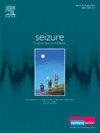Characterizing CHD2-associated epilepsy: A multicenter study and pooled analysis of the literature
IF 2.8
3区 医学
Q2 CLINICAL NEUROLOGY
引用次数: 0
Abstract
Background and objectives
CHD2 variants have been implicated in a spectrum of neurodevelopmental disorders, including early-onset developmental and epileptic encephalopathy. Despite growing interest in CHD2-related disorders, the full phenotypic spectrum, including epilepsy features and genotype-phenotype relationships, is not fully understood. This study aims to systematically review the literature and analyze data from a multicenter registry to independently describe phenotypic and genotypic features of CHD2-associated epilepsy.
Methods
A systematic literature review was conducted from inception to 7/2024 using EMBASE, Web of Science, and PubMed with the keywords "CHD2”. Additional data was collected from a search of the Pediatric Epilepsy Research Consortium (PERC) Epilepsy Genetics Database and the same parameters were used to gather relevant information about patients with both CHD2 variants and epilepsy.
Results
Of the 644 screened articles, 74 articles containing individual participant data were included for full-text review and analysis, focusing on parameters such as CHD2 variants, clinical characteristics, neuroimaging findings, and electroencephalography (EEG) results. Data from 236 individuals with epilepsy and CHD2 variants were included, including 12 previously unreported cases from the PERC Genetics database. Of the patients with available data, 53% (108/205) were male, and 95% (170/179) had confirmed de novo mutations. Seizure onset ranged from 1 day to 22 years, with 59% (80/136) of the cases exhibiting photosensitivity and 37% (33/90) fever sensitivity. Most common comorbidities included intellectual disability (86%, 121/141), developmental delay (88%, 156/177), and autism (45%, 68/150). EEG showed epileptiform abnormalities in 88% (122/138) of the cases. MRI findings were abnormal in 19% (22/116) of patients.
Discussion
CHD2-associated epilepsy presents with considerable phenotypic variability, including variable age of seizure onset, photosensitivity, and neurodevelopmental comorbidities. This review highlights the importance of comprehensive phenotypic-genotypic characterization to better understand the clinical spectrum of CHD2 variants, emphasizing the need for further investigation into the mechanisms driving phenotypic diversity.
chd2相关癫痫的特征:一项多中心研究和文献汇总分析
背景和目的chd2变异与一系列神经发育障碍有关,包括早发性发育性脑病和癫痫性脑病。尽管人们对chd2相关疾病的兴趣日益浓厚,但包括癫痫特征和基因型-表型关系在内的完整表型谱尚未完全了解。本研究旨在系统地回顾文献并分析来自多中心注册的数据,以独立描述chd2相关癫痫的表型和基因型特征。方法采用EMBASE、Web of Science和PubMed检索系统,检索关键词“CHD2”,从成立至2024年7月进行文献综述。其他数据来自儿科癫痫研究联盟(PERC)癫痫遗传学数据库的搜索,并使用相同的参数收集CHD2变异体和癫痫患者的相关信息。结果在筛选的644篇文章中,74篇包含个体参与者数据的文章被纳入全文综述和分析,重点关注CHD2变异、临床特征、神经影像学发现和脑电图(EEG)结果等参数。研究纳入了236例癫痫和CHD2变异患者的数据,其中包括PERC遗传学数据库中以前未报道的12例病例。在现有资料的患者中,53%(108/205)为男性,95%(170/179)确诊为新生突变。发作时间从1天到22年不等,59%(80/136)的病例表现为光敏,37%(33/90)的病例表现为发热敏感。最常见的合并症包括智力障碍(86%,121/141)、发育迟缓(88%,156/177)和自闭症(45%,68/150)。脑电图显示癫痫样异常占88%(122/138)。19%(22/116)患者MRI表现异常。chd2相关癫痫表现出相当大的表型变异性,包括癫痫发作年龄、光敏性和神经发育合并症。这篇综述强调了综合表型-基因型表征对更好地了解CHD2变异的临床谱的重要性,强调了进一步研究驱动表型多样性的机制的必要性。
本文章由计算机程序翻译,如有差异,请以英文原文为准。
求助全文
约1分钟内获得全文
求助全文
来源期刊

Seizure-European Journal of Epilepsy
医学-临床神经学
CiteScore
5.60
自引率
6.70%
发文量
231
审稿时长
34 days
期刊介绍:
Seizure - European Journal of Epilepsy is an international journal owned by Epilepsy Action (the largest member led epilepsy organisation in the UK). It provides a forum for papers on all topics related to epilepsy and seizure disorders.
 求助内容:
求助内容: 应助结果提醒方式:
应助结果提醒方式:


